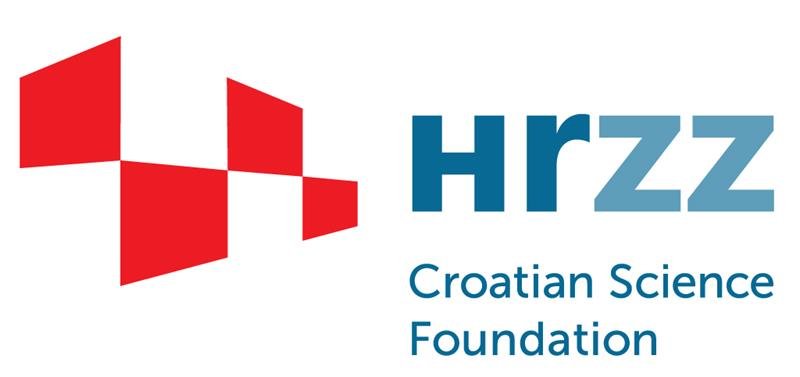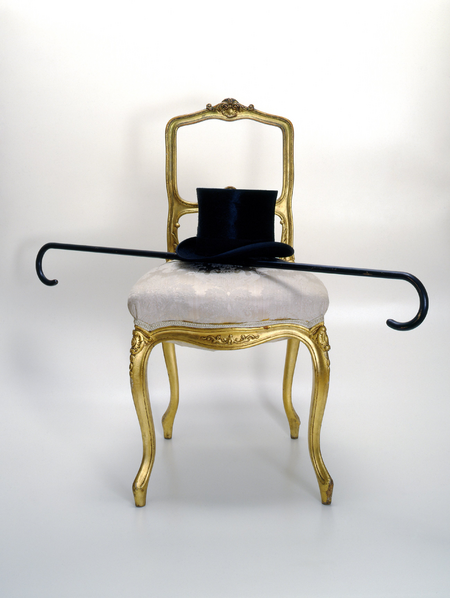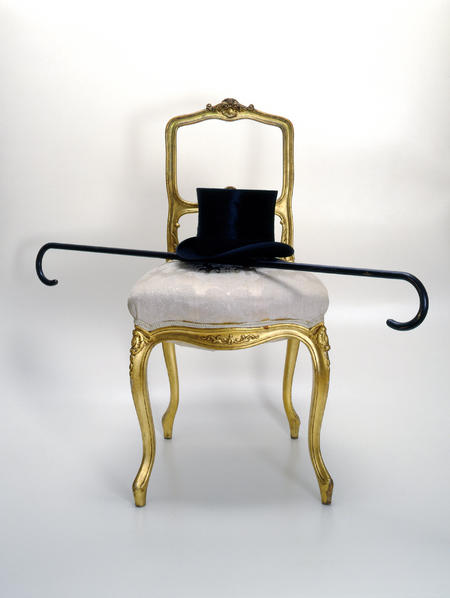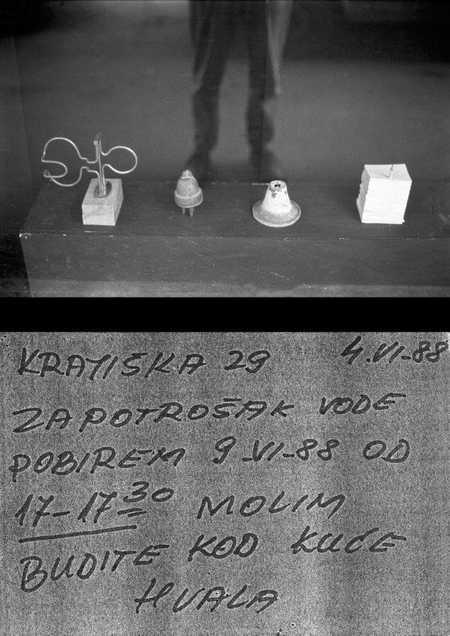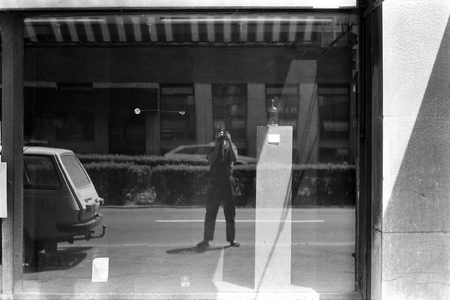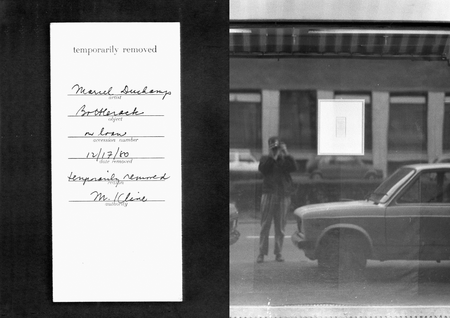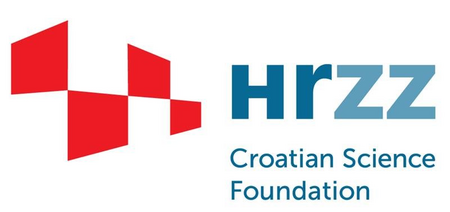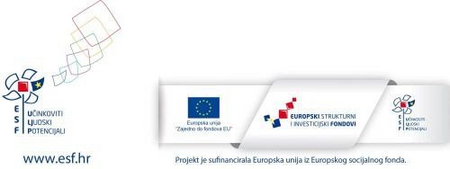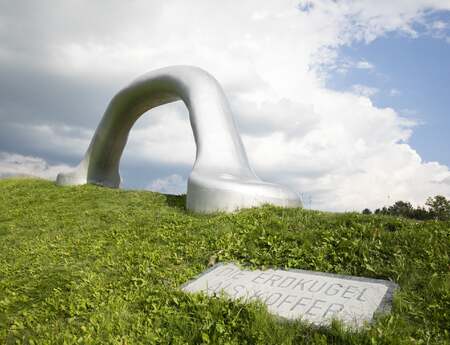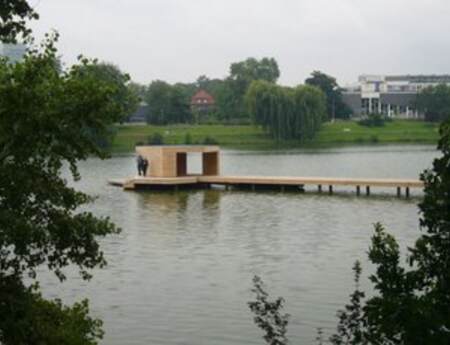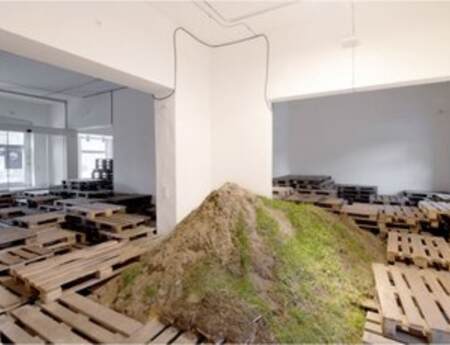Modern and Contemporary Adaptations of the Readymade Strategy in Sculptural Practices on the "Periphery" of Europe
For some, the title of this article may raise questions (what exactly are “readymade strategies”?), or even cause offense at the term “periphery” due to its negative, or at least questionable connotations. The word “contemporary” is, hopefully, the least ambiguous of the lot. And what about “sculptural practices”? Is that not too vague a term? Why not simply say “sculpture”? Perhaps it is therefore best to sequentially explain what is implied by each of these terms – at least in the confines of this text – before continuing to address the main issue at hand: how artists adapt their praxis by borrowing from the past and appropriating their newfound knowledge to accommodate the (artistic, social, political, etc.) needs of the present.
The term “periphery” is one which initially deserves slightly more attention seeing as it will provide the necessary geographic context. What is meant here by “the periphery” are spaces on the brink of certain cultural and artistic trends; those to which it takes slightly longer for certain phenomena to arrive due to various circumstances. It is important to note that this term is in no way used pejoratively here, but simply as a geographical marker and descriptor. Geographically speaking, the periphery being addressed in this article is the Balkan peninsula, or even more precisely, modern-day Croatia. As a disclaimer, as of Croatia’s entrance into the European Union in 2013, it has somewhat detached itself from the very broad and rather ambiguous term of “the Balkans” (in the cultural sense of the term). Whether or not Croatia is part of the Balkans, geographically or culturally, shall not be discussed here as this has been a topic of endless dispute – some have labeled it part of Central Europe and even Eastern Europe. Regardless, it has historically been a region whose artists have rarely been “trend-setters” and more frequently followed and imported trends (through their education, trips, and exhibitions abroad) from the so-called “centers of culture” such as Prague, Wien, Munich, Paris and New York. This is not to say that Croatian artists were isolated, or out of vogue, or rigidly conventional. On the contrary – many artists and artist groups (primarily located in the country’s capital city Zagreb) showed strong avant-garde tendencies that were on par with those of wider European and even global practices. This may only have taken slightly longer to occur than in the “centers”. This has been noted by local art historians such as Ješa Denegri who recognized the use of “peripheral” as an autocritical, even self-pitying term which can and should be challenged. He observed that “A milieu which had such a cultural center [as Zagreb], which was capable of forming currents of radical artistic stances and maintaining close relations with European artistic dimensions akin to their own, should, for the sake of self-identification, no longer use categories such as those that speak of a peripheral structure; it should not look for alibies in that it deems itself a local environment. Surely, art has countless ways of coming into existence in every milieu, but preceding all of them, there is a common urgent claim: to take part in the large, global exchange of artistic problems and ideas, to be present on the stage on which global artistic processes are taking place during varied historical moments” (translated by the author of this text). Another important Croatian art historian who dealt with issues of “the periphery” (albeit in the greatly differing context of predominantly medieval and Renaissance architecture and architectural decoration in Croatia) was Dr Ljubo Karaman. He differentiates between provincialized art, art of marginal areas and art of peripheral areas. He differentiates between these terms but also notes the need to approach them critically and flexibly. Briefly and simply put, all of these terms are geographical to a certain extent. However, provincialized art is art which mainly borrows from/is inspired by the art of solely one area (and is often overshadowed by it partially due to its more modest social and economic circumstances). Marginalized areas, on the other hand, borrow from several significantly differing loci at a time, which results in new artforms being produced, but still with visible influences. Art of peripheral areas is, in a way, the most advanced artform of the three because it is eclectic (borrowing simultaneously from many cultural centers and periods in time) and is characterized by a dose of free expression in that it borrows, adapts, refines and generally reworks what is has borrowed to create a differing and individual form of expression (Karaman, 6 – 8). All things considered, the use of the term “peripheral” in the title of this article complies with Karaman’s use of the term seeing as Croatian modern and contemporary artists, as will be demonstrated, eclectically appropriated what they needed regardless of the geographic or temporal boundaries of the source(s) at hand.
This transmission of ideas and artistic practices includes a wide array of sculptural practices, among others. The use of the term “sculptural practices” is a matter of precision in this case. To clarify, in the fields of modern and contemporary sculpture, one can notice the use of several conflicting terms to refer to three-dimensional artistic practices (apart from architecture) – sculpture, sculptural practices, objects, structures, or simply three-dimensional works. This points to the issue of terminological imprecision as well as (intentional) artistic ambiguity. The author therefore feels the need to clarify what is referred to in this text with the term “sculptural practices” and how this terminological ambiguity is actually an integral part of modern and contemporary sculptural practices. The term “sculptural practices” is used here simply to illustrate that contemporary sculpture does not always imply traditional sculptural mediums and can take on a variety of forms. Generally speaking, all three-dimensional artworks now fall into the category of “sculpture” (either that, or architecture), many of which are temporary (actions, happenings, performances), ephemeral (those using corrosive and natural materials), conceptual or perhaps “dematerialized” (to use Lucy Lippard’s term). Clearly, at some point in time, “sculpture” turned into “sculptural practice” to allow for a greater number of artistic works into the canon of art history. And why not? Cultures change; society changes; the environment and context changes. It is only to be expected and should be deemed natural that art, in this case sculpture, should adapt as well.
One specific adaptation of sculpture in particular is of interest here – the ready-made. The term was appropriated by the artist Marcel Duchamp in 1915, though he produced the first ready-made two years earlier. Most interestingly, he had admitted in interviews that he had never truly managed to come to a precise definition of this sculptural form. However, we were most generously provided one by his contemporary André Breton who defined the ready-made as “an ordinary object promoted to the dignity of art object simply by way of the artist's choice” (de Duve, 92). The way Duchamp “adapted” sculpture to his time and place was by trying to eliminate what he labeled as the “retinal” in art (that which exists solely for the purpose of visual pleasure) and put an emphasis on the intellectual aspect of art. Thus, the objects he chose to put on an artistic pedestal (metaphorically and even literally as is illustrated by his infamous Fountain from 1917) were not meant to be pleasing to the eye; they were supposed to be “anesthetic”, in Duchamp’s words. In fact, the artist and viewer alike were supposed to remain neutral towards it. The ready-mades were objects, but their objecthood was the least important aspect of the artworks. They were essentially created as a way of testing the system we call art (what Arthur C. Danto and George Dickie call the Artworld), provoking, challenging established notions of art, artists, creativity, originality, even seriousness in art. They were intellectual in their core and were meant to be understood conceptually (it is clear where this road led to a few decades later). The ready-mades were therefore a reaction to, in Duchamp’s view, a stale art which was desperately in need of reconfiguration if it was to answer to the demands of contemporary society which was in turmoil during this period. As the Dadaists, Futurists and later on Surrealists demonstrated, even Cubists (all of which Duchamp can be related with to a larger or lesser degree), a society shaken up by war(s) needs a new form of art; one that is equally unsettled and provocative.
Clearly, the prime focus of this article shall be on sculpture, mainly that of contemporary artists (i.e. those still living or, in a few cases, those that have just recently passed away), but hearkening back to their modern predecessors (Duchamp mostly) without which some of the aforementioned contemporary “sculptural practices” would have been inconceivable, or at least long delayed. As a disclaimer, it is necessary to note that this article covers a slightly wider time range so as to provide a broader and thus more accessible context in which to interpret the cause-effect stream of events which led to the appearance of the ready-made in Croatia.
Some artworks would possibly have simply been still-born had they not been created at that specific time, for that specific audience. They simply would not have conveyed their message completely and appropriately. That being said, it is also worth considering the wise words of Peter Burger from his canonical Theory of the Avant-Garde: “…whereas art forms owe their birth to a specific social context, they are not tied to the context of their origin or to a social situation that is analogous to it, for the truth is that they can take on different functions in varying social contexts” (Bürger, 69). This may happen over time and space as Bernice Murphy demonstrated in her text “Marcel Who? (The Readymade in the Context of the Province”)” explaining that “By the time the Duchampian Readymade arrives in the province, its meaning is already transformed by the conversionary effects of its long passage from the centre. Marcel's bottle rack . . . would already have been a highly exotic and strange object by the time it had found its way from a batterie-de-cuisine store in Paris…” (Murphy, 112). She continues to explain that the idea of the “original artwork” (however relative it may be in the context of the readymades) carries much more weight in metropols. The province, on the other hand, is rarely introduced to originals and more often to copies of artworks, be it through physical reproductions or photographic ones (Murphy, 117). Croatia was no exception.
When it comes to international relations and news of global/European artistic practice, Croatian artists were well-connected and well-informed (some were also incredibly well-versed in art theory). Despite this, the concept of the ready-made as such did not arrive in Croatia until the 1960s in the work of the Gorgona group which is considered a precursor to Croatian Conceptual art. Prior to this, Croatian (or rather Yugoslavian) artists had been applying certain appropriation strategies in their work since the 1920s by creating collages and assemblages into which they occasionally incorporated found objects and discarded materials (for those more interested in the subject, the works of Josip Seissel a.k.a. Jo Klek or Antun Motika could be of interest). However, Duchamp’s direct influence was not visible until the members of the Gorgona group received news of Duchamp’s ideas through their friends and correspondents in Paris. Alas, the artistic activity of this group was mainly carried out in private so the idea of the ready-made did not have much of a chance to spread just yet. Albeit, their artworks were “rediscovered” in the late 1970s and presented to the wider public in their retrospective exhibition in 1977 at the Gallery of Contemporary Art in Zagreb. A wave of recognition ensued as the members of the group were hailed as the forefathers of Conceptual art with their emphasis on the idea behind the artwork itself, the dematerialization of the art object, the use of absurdity and puns and the minimization of the role of aesthetics (all of which were also principles that Duchamp himself championed). It is important to note that many of the works related to the concept of the ready-made that were created by the Gorgona artists and thereafter were not necessarily “pure ready-mades” (objects simply taken and appropriated with no/minimal intervention on behalf of the artist). Many of them were assisted ready-mades (one or several ready-made objects combined to form a new object in which the artist’s hand still made as little interventions as possible to convey the message). The most famous example in the context of this time and place would have to be an assisted readymade (then simply labeled as an installation) by Josip Vaništa, a member of the Gorgona group who can be considered both modern and contemporary (he passed away just recently at the beginning of 2018). The work in question is entitled Infinite Cane - Homage to Manet from 1961 (image 1) which consists of an armchair and top hat (both of which the artist got from local people through advertisements in the newspaper) and a double-sided and therefore functionless cane which the artist had made according to his instructions specifically for the purpose of this installation/ready-made. There were many other examples of course, both by Vaništa and several other members of the Gorgona group, but the timeline, as well as this article, must go on.
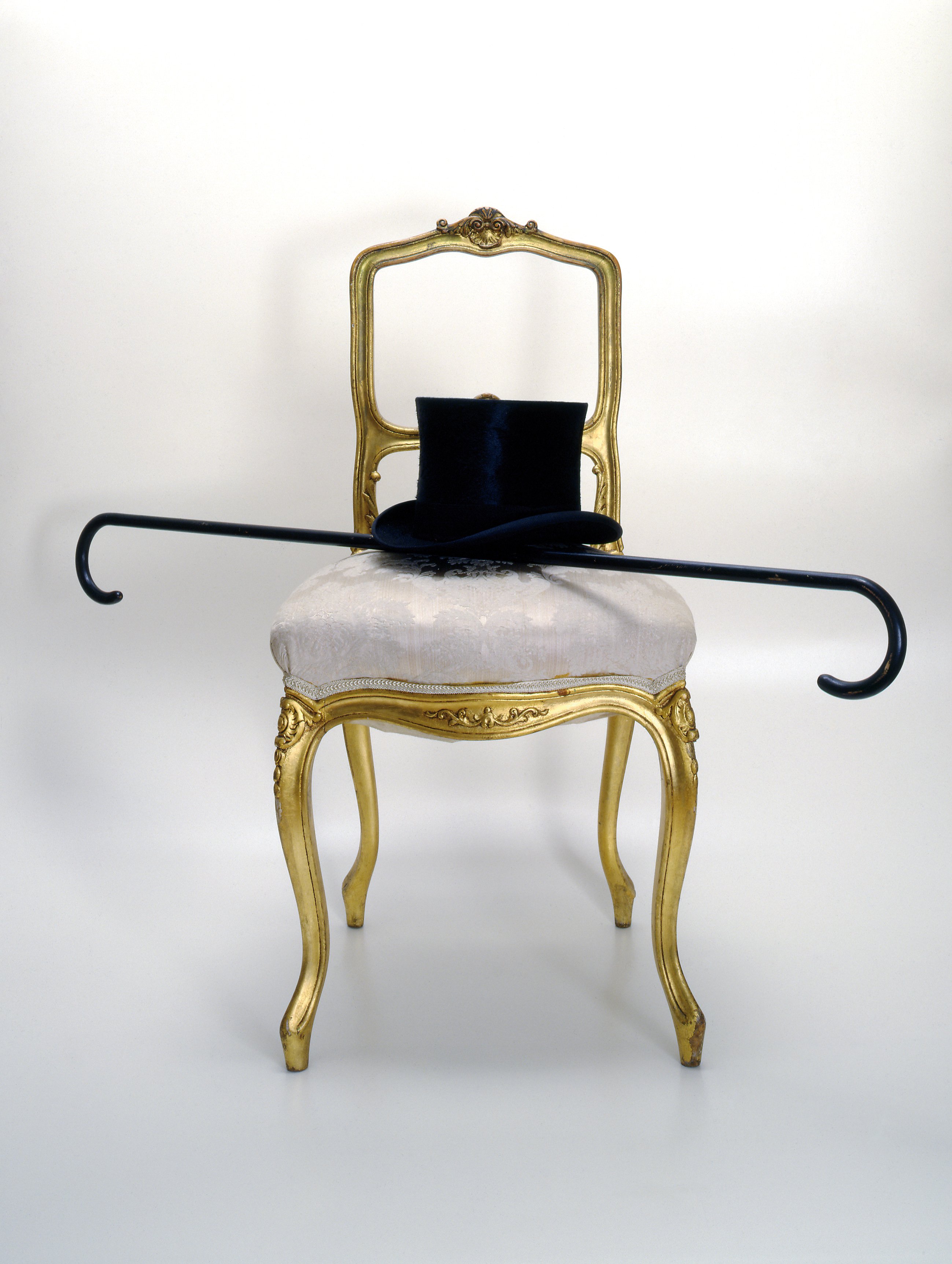
Josip Vaništa, Infinite Cane - Homage to Manet,87 x 112 x 50 cm (1961)
Copyright: Museum of Contemporary Art Zagreb (Muzej suvremene umjetnosti Zagreb), photo by Boris Cvjetanović. Photo source: Documentation and Information Department of the Museum of Contemporary Art Zagreb
After this retrospective, younger artists (many of whom are now considered part of the New Art Practice that emerged in the late 1960s and lasted throughout the 1970s in Yugoslavia) decided to engage even more with the idea of the ready-made. This coincided with the publishing of a booklet by the Museum of Contemporary Art in Belgrade (1984) which marked the first translation of Duchamp’s texts in Yugoslavia. Among these texts was the canonical “Apropos of readymades” (Gavrić, 47) which, from then on, became available to Yugoslavian artists and the general public. In February and March of the same year, Duchamp’s La boite en valise was presented at the Museum of Contemporary Art in Zagreb (Catalogue, 716). This in itself was an important moment in this chronicle of events as it was the first time that a Duchamp could be viewed by Croatian artists and art-goers. Already in 1988, the first exhibition to incorporate the term “ready-made” into its title was held in the shop window of a local bookstore in Zagreb (images 2 - 4). The exhibition was organized and documented by the photographer and now curator Žarko Vijatović. The somewhat improvised booklet that accompanied the exhibition included the same translation of “Apropos of readymades” from the aforementioned booklet by the MCA in Belgrade (and references it), which clearly proves that, by this point in time, local artists and art historians were well-aware of Duchamp’s artistic philosophy. The “booklet” itself was handed out only to the artists that exhibited – “booklet” being in quotation marks because it was actually a compilation of photocopied photographs of the works preceded by the “Apropos of readymades” text and followed by a photocopy of a newspaper article referencing the exhibition (an interview with Mr Vijatović) and only a paragraph of text by the photographer himself. By creating an “exhibition catalogue” which was almost in its entirety unoriginal, Vijatović was referring to Walter Benjamin’s idea of the “loss of aura” of artworks through the act of reproduction (an idea which was familiar to the Gorgona group and other artists of this time).
The 1988 exhibition entitled “Ready-mades” actually consisted of nine consecutive modest solo exhibitions by different artists. One of them was, not surprisingly, Josip Vaništa. Two of his fellow Gorgona friends also took part (Dimitrije Bašičević a.k.a. Mangelos and Julije Knifer). However, some younger-generation artists were also included and it is through them, and consequently their influences, that the readymade strategy continues to flourish throughout the 90s and 2000s. The names this author feels obliged to mention here are Tomislav Gotovac, Vlado Martek, and Goran Trbuljak. Tomislav Gotovac exhibited a number of objets trouvés which he had simply picked up off the sidewalk as well as a hand-written notice from his building regarding a tenant meeting which he simply appropriated for the sake of the exhibition (image 2). Vlado Market exhibited a bottle and empty glass along with a sheet of poetry (related to the comfort of drinking) which he slightly modified by writing over it (image 3). Goran Trbuljak’s work (image 4) is most relevant for the contemporary context as it was re-exhibited at the exhibition “The art of appropriation” held in the Forum Gallery, Zagreb in 2017. It consisted solely of a label which was “borrowed” (i.e. stolen) from the Philadelphia Museum of Art and then framed. It stated that Duchamp’s Bottlerack was “temporarily removed”. The idea behind this piece was simple – the label replacing the original artwork is equal to the artwork itself (Ready-mades, 21). It is clear how close Trbuljak is to Conceptual art from this elaboration alone.
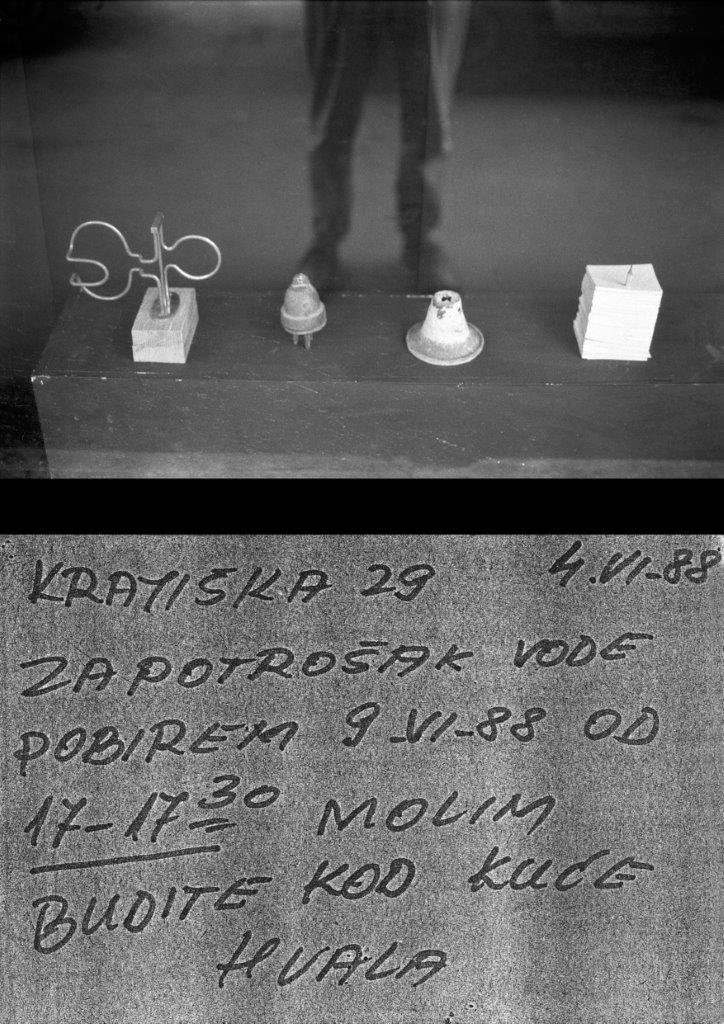
Tomislav Gotovac, unknown (ready-mades exhibited in the shop window of the bookstore Znanje-August Šenoa in Zagreb) (1980-1990)
Copyright: Žarko Vijatović. Photo source: private photo collection of Žarko Vijatović
Trbuljak and Martek are still alive and well, whereas Vaništa passed away early this year and Gotovac passed away in 2010. Notably, the work of both Vaništa and Gotovac proved to be extremely influential for the younger generations of artists with which they exchanged ideas (Vaništa even teaching some of them – including Gotovac). Gotovac, for example, continued his experimentation with the idea of the ready-made with his “ready-made movies” from 2010. Each movie consists of a longer segment he took from another movie and the opening credits which simply state the name of the movie and its author – Tomislav Gotovac (Šimičić, 8-9). Vaništa also continued to apply appropriation strategies in his art, or principles close to those of Duchamp, such as the appropriation and repetition of the image of Mona Lisa throughout the entire sixth number of the Gorgona magazine (proving his awareness of Walter Benjamin’s ideas as explained in his text “The Work of Art in the Age of Mechanical Reproduction”) or using others’ photographs and just slightly touching them up to create “portraits” of the other members of the group. Trbuljak was to continue his work in the conceptual sphere and did not create ready-mades per se, though he did continue to question the role of the artist as creator, art institutions and the idea of art overall. He did, however, come close to creating more ready-mades with his “photographic installations” i.e. Psycho-installations from 1993 in which he took/combined everyday objects he no longer wanted to keep such as old radios, scales, and general household items and photographed them just to save their memory before discarding them (Stipančić, 123-124). This was an interesting combination of photography, assisted ready-mades (akin to Duchamp’s Bicycle Wheel) and a strange sort of “reverse” trash art, or perhaps actual trash art, in a sense, since the objects taken were already considered useless and made even more useless when their functions were stripped from them after they underwent their artistic transformations and alterations. Martek continued his work in the conceptual domain and in the Group of Six Authors throughout the 70s and early 80s, later branching out as a solo artist. However, his later work was concerned much more with the integration of words and art (he considered himself more as a poet), often conveying messages with humorous undertones and playing with words (as Duchamp also did in his inscriptions on the ready-mades).
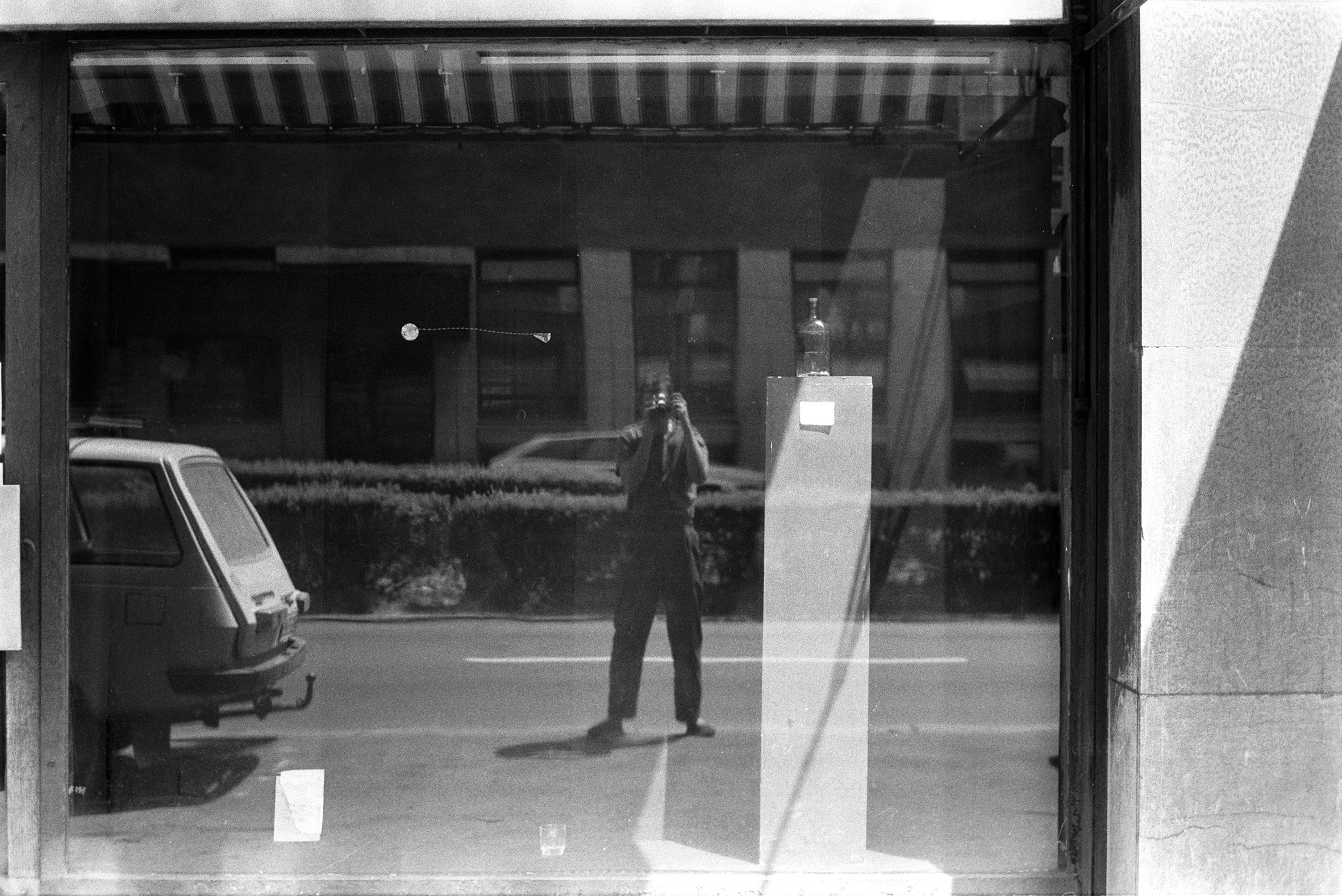
Copyright: Žarko Vijatović, Photo source: private photo collection of Žarko Vijatović
Trbuljak and Martek are still alive and well, whereas Vaništa passed away early this year and Gotovac passed away in 2010. Notably, the work of both Vaništa and Gotovac proved to be extremely influential for the younger generations of artists with which they exchanged ideas (Vaništa even teaching some of them – including Gotovac). Gotovac, for example, continued his experimentation with the idea of the ready-made with his “ready-made movies” from 2010. Each movie consists of a longer segment he took from another movie and the opening credits which simply state the name of the movie and its author – Tomislav Gotovac (Šimičić, 8-9). Vaništa also continued to apply appropriation strategies in his art, or principles close to those of Duchamp, such as the appropriation and repetition of the image of Mona Lisa throughout the entire sixth number of the Gorgona magazine (proving his awareness of Walter Benjamin’s ideas as explained in his text “The Work of Art in the Age of Mechanical Reproduction”) or using others’ photographs and just slightly touching them up to create “portraits” of the other members of the group. Trbuljak was to continue his work in the conceptual sphere and did not create ready-mades per se, though he did continue to question the role of the artist as creator, art institutions and the idea of art overall. He did, however, come close to creating more ready-mades with his “photographic installations” i.e. Psycho-installations from 1993 in which he took/combined everyday objects he no longer wanted to keep such as old radios, scales, and general household items and photographed them just to save their memory before discarding them (Stipančić, 123-124). This was an interesting combination of photography, assisted ready-mades (akin to Duchamp’s Bicycle Wheel) and a strange sort of “reverse” trash art, or perhaps actual trash art, in a sense, since the objects taken were already considered useless and made even more useless when their functions were stripped from them after they underwent their artistic transformations and alterations. Martek continued his work in the conceptual domain and in the Group of Six Authors throughout the 70s and early 80s, later branching out as a solo artist. However, his later work was concerned much more with the integration of words and art (he considered himself more as a poet), often conveying messages with humorous undertones and playing with words (as Duchamp also did in his inscriptions on the ready-mades).
The readymade strategy in Croatia followed a trajectory similar to that in the rest of Europe, slowly infiltrating Conceptual art and setting the stage for installations. The line between installations and ready-mades is often blurred (as demonstrated in Vaništa’s Infinite Cane), especially when the installations are smaller in size and consist solely/mostly of ready-made objects which are combined to form a new artistic product. This is worth mentioning as the work of the final two artists presented in this article are often labeled as such.
A contemporary artist closely connected to Martek through the Group of Six Authors is Mladen Stilinović. Throughout his artistic career, he has challenged the boundaries of art and societal norms through his installations, environments and even occasional collages (which are in themselves a kind of readymade artistic strategy). He has produced entire series of works based on and using money, modifying it occasionally (writing on it, cutting it up), or arranging it to create larger spatial installations. He has incorporated various everyday objects into his installations such as bread (albeit colored) and pastries, sugar packets, alarm clocks, pillows, kitchen utensils (most commonly plates and spoons), and so on (a comprehensive portfolio of his works can be seen on his website listed in the references below). Of course, all of this was done with intent – not aesthetic intent, but rather the idea of spreading a specific message, often (anti)political, critical and challenging for the viewer. He went on to directly “quote” Marcel Duchamp in three works dating from 2009 and 2011 respectively entitled I am Selling M. Duchamp, I am Selling M. Duchamp, H. U. O., H. I. H. I. (resembling Duchamp’s L.H.O.O.Q. by name) and I am Selling M. Duchamp again. However, none of these three works are ready-mades as they were made by the artist hand-painting these precise words onto pieces of fabric or cardboard. Yet, they are proof of Duchamp’s import for Martek and the overall artistic climate.
The youngest artist that will be addressed here has no direct connection to the aforementioned ones, but some of his artworks (mainly installations) can be closely related to Duchamp. Viktor Popović made installations of piled up chairs and argon gas tubes in 2006. The chairs were previously used, bearing traces of this detrition on their wooden surfaces, and borrowed for the purpose of the installation during the artist’s stay in Portland, USA. As is to be expected when a chair is turned over, they were rendered functionless just as Duchamp’s bar stool in his Bicycle Wheel had been almost a century ago. As Popović himself explains, the chairs “were removed from their original context, preventing their use as functional objects” and were placed in a new context; an artistic one (Popović). This description is dangerously close to the definition of the ready-made as provided by Breton. But another series of works which this author cannot resist associating with another work by Duchamp was produced in 2007. The installations (images visible on the artist’s web site listed in the references below) consist of borrowed everyday objects which were covered with a thick rubber sheet so they are invisible, or just barely visible to the spectator. They are thus veiled in mystery. Popović explains: “The selected objects, hidden under identical pieces of rubber, were only vaguely visible, while the observer, aware of the fact that they were exhibited artworks and therefore not to be touched, was left to guess and speculate” (Popović). The important connection with Duchamp lies in the objects presented (or rather hidden). They were typewriters. Duchamp himself had referenced a typewriter in one of his works, though he applied a diametrically opposed strategy to that of Popović. Whereas Popović hid his typewriters under thick rubber, Duchamp exhibited an Underwood typewriter cover (Traveller's Folding Item / ...pliant,... de voyage, 1916.) without the typewriter.
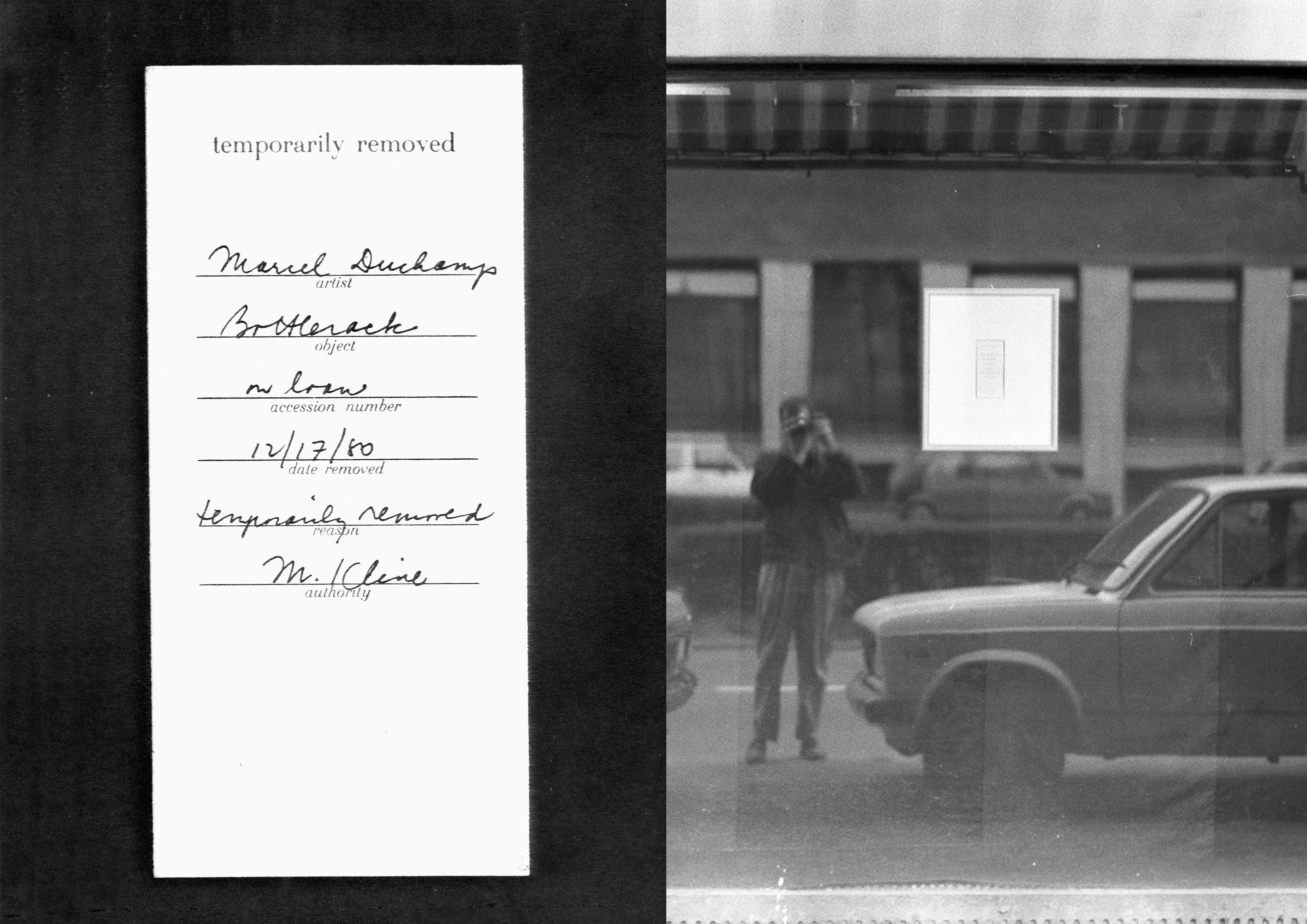
Goran Trbuljak, Without the knowledge of the museum's administration, alienated information about the loan, thinking it is identical to the original tor which it stands in, 20 x 30 cm, 1981
Copyright: Žarko Vijatović, Photo source: private photo collection of Žarko Vijatović
Marcel Duchamp greatly influenced generations of artists, not least in Yugoslavia (and Croatia), but from all over the globe – from Manzoni to Fontana, Rauschenberg and Johns, Warhol and Ai Weiwei, Sherrie Levine and Jimmie Durham… The list goes on. A testament to this are the words that Arthur C. Danto has to offer on the subject: “…Marcel Duchamp whom Jean Clair regards as ‘primus inter pares.’ Duchamp, more than anyone else, insinuated the disgusting into the contemporary artistic repertoire when he attempted to enter a urinal as a work of art into the Exhibition of Independent Artists in New York, in 1917. It was unmistakably a urinal, despite its having been signed and dated R. Mutt, 1917, and it has, far more than Manzoni's or even Beuys's works, attained a legendary stature in the annals of twentieth century art” (Danto). The effects of his ideas were far-reaching and overcame all boundaries; temporal, geographic, societal and generational. If Cezanne is considered the father of modern art, then Duchamp can easily be considered, if not the father of the avant-garde, then at least its primary delegate. The precursor to Conceptual art and the breaker of barriers, Duchamp freed three-dimensional art of its bodily boundaries and enabled future generations of artists to use a limitless array of materials (many of which, if not most, were “non-artistic”) or perhaps disregard materiality altogether. Being ahead of his time, he realized the need for a form of artistic expression that goes beyond the retinal and engages the synapses. In our modern consumerist, material age, the contemporary art viewer and artist can only find solace and respite in such immaterial works and be provoked into actually thinking (for a change); engaging their mind actively in the interpretation of a work of art. In this age of passivity – passive absorption of media, idle newsfeed scrolling, mindless shopping, ready-made food and services that cater to our every whim – some mental activity is more than welcome. In a sense, these omnipresent social issues are combated by artists from both the “centers” and “peripheries” through the adoption of readymade artistic strategies. Is there any better way to fight the pervading readymade lifestyle we now live?
References:
1. “Antun Motika,” Avantgarde Museum, February 14, 2017, https://www.avantgarde-museum.com/en/museum/collection/authorsantun-motika~pe4502/
2. Bürger, Peter. Theory of the Avant-Garde, Minneapolis: University of Minnesota Press, 1984.
3. Catalogue of the Collection; Chronology of Exhibitions, ed. Snježana Pintarić, Zagreb: Museum of Contemporary Art, 2008.
4. Danto, Arthur C. "Marcel Duchamp and the End of Taste: A Defense of Contemporary Art," Tout-fait, December 2000., http://www.toutfait.com/issues/issue_3/News/Danto/danto.html
5. De Duve, Thierry. Kant After Duchamp, London: The MIT Press, 1996.
6. Denegri, Ješa. Prilozi za drugu liniju: kronika jednog kritičarskog zalaganja, Zagreb: Horetzky, 2003.
7. Gavrić, Zoran. Marcel Duchamp: izbor tekstova, Beograd: Muzej savremene umetnosti, Beograd, 1984.
8. “Josip Seissel (Jo Klek),” Avantgarde Museum, September 4, 2010, http://www.avantgarde-museum.com/hr/museum/kolekcija/JOSIP-SEISSEL-JO-KLEK~pe4481/
9. Karaman, Ljubo. O djelovanju domaće sredine u umjetnosti hrvatskih krajeva, ed. Milan Prelog, Zagreb: Društvo historičara umjetnosti NRH, 1963.
10. Murphy, Bernice. “Marcel Who? (The Readymade in the Context of the Province),” in: The Readymade Boomerang: Certain Relations in 20th Century Art, ed. Rene Block, Sydney: The Biennale of Sydney, 1990.
11. Popović, Viktor. “Works,” Viktor Popović, August 23, 2017, http://www.viktorpopovic.com/page1/page22/
12. Ready-mades, autorski izlog knjižare Znanje - August Šenoa, ed. Žarko Vijatović, exhibition catalog, Zagreb: 1990.
13. Stilinović, Mladen. “Works,” Mladen Stilinović, October 4, 2013, https://mladenstilinovic.com/works/11-2/
14. Stipančić, Branka. Mišljenje je forma energije: eseji i intervjui iz suvremene hrvatske umjetnosti, Zagreb: Arkzin: Hrvatska sekcija AICA, 2011.
15. Šimičić, Darko. Tom Gotovac / Strategija readymadea, exhibition catalog, Zagreb: Galerija Forum, 2017.
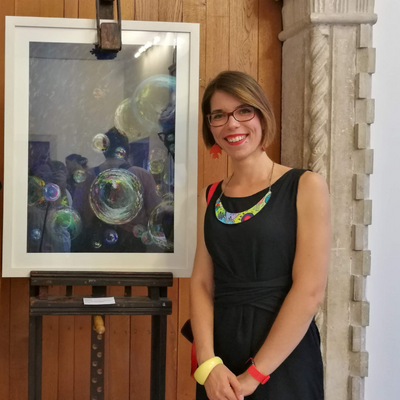
Author:
Dora Derado received her MA in Art History from the Faculty of Humanities and Social Sciences, University of Split in 2016. She enrolled in the Postgraduate program of Art History at the Faculty of Humanities and Social Sciences, University of Zagreb in 2017 where she is working on her doctoral thesis “Provoking Art History: Readymades and Changes in the Perception and Status of Artworks (Reflections on 20th Century Art and Visual Culture in Croatia)”. She is an associate on the research project “Manifestations of Modern Sculpture in Croatia: Sculpture on the Crossroads between Socio-political Pragmatism, Economic Possibilities and Aesthetical Contemplation” (Crosculpture) which is under the patronage of the Croatian Science Foundation. She has been actively engaged in the field of art history since her time at university, organizing several international conferences and curating solo and group exhibitions. Since then, she has continued these practices mainly under the Crosculpture project. Her current research interests include art theory, twentieth-century art and contemporary art, with a focus on sculpture, as well as the intermingling of ideas which permeate all of these topics and facilitate the development of art theories accommodated to the understanding and interpretation of art overall as well as specific socio-cultural questions stemming from this.
This work has been fully supported by Croatian Science Foundation under the project IP-2016-06-2112 „Manifestations of Modern Sculpture in Croatia: Sculpture on the Crossroad between Socio-political Pragmatism, Economic Possibilities and Aesthetical Contemplation“.
